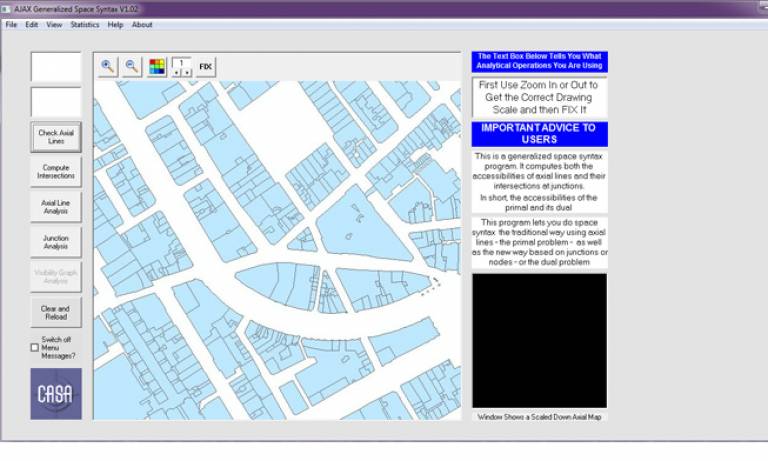
This is a Windows-based program for generalised space syntax. It enables users to perform traditional space syntax, called the primal analysis, which consists in describing a spatial configuration as a set of axial lines and working out their relative proximities, accessibilities or integration values. But the program also enables users to generate the dual analysis, which consists in working out these same accessibilities with respect to the intersections between the lines that we call junctions or nodes.
You can download the current version from this page. We are not supporting the program in any way as it is free and currently under rapid development. New versions will come online as they are produced and can be downloaded from this page. We will let the Space Syntax Mail Base List know each time a new version of the program becomes available.
The program is quite user friendly and as yet there is no help. We have put up a pdf file you can download with an example of how to use it - this is for the previous versions and the current versions v1.02 has much much more functionality - but we hope it is self-explanatory. A full manual has not yet been written but the next version will be v1.10 and we will have a manual for that one with all bugs ironed out.
Users can email Professor Mike Batty if there are any unwitting crashes. For previous versions, we have encountered an error for some versions of Windows and if you get an error message asking for some missing .ocx component, then the way to remedy this is search Google and download the patch. In the current version, we hope this has been resolved as we are no longer using APIs.
The program essentially lets you input your own map and then draw axial lines on it so that the analysis can be generated. You can save data from the program and save the maps you generate. You can adjust your map to the screen size by zooming and this means you can use it on most PCs.
In the current version (v1.02) we have added a lot more functionality, namely
- changing color and width of the line drawing with the mouse
- adding radius-3 axial and junction maps to the syntax
- adding zoom capability to the radius-n of the axial and
- junction maps
- adding depth maps from any line or junction
- adding axial graphs and junction graphs from the axial maps and junction maps
- adding zoom capability to the distances associated with the axial and junction maps
The program is restricted to 500 axial lines but it would take several minutes to process a problem this size. Problems with less than 100 lines and/or nodes are very fast. On my laptop which is a SONY Vaio R600 (circa 2002) with Pentium III running at 844 MHz with 256K RAM, a 25 line or node problem takes 1 second, a 50 line/node 2 seconds, a 100 line/node 5 seconds, a 250 line/node problem 150 seconds and so on...
You are welcome to try it out. For future versions, I will ask you to register but for these early versions, no registration is required.
The ideas are based on CASA Working Paper 75 "A New Theory of Space Syntax".
 Close
Close

